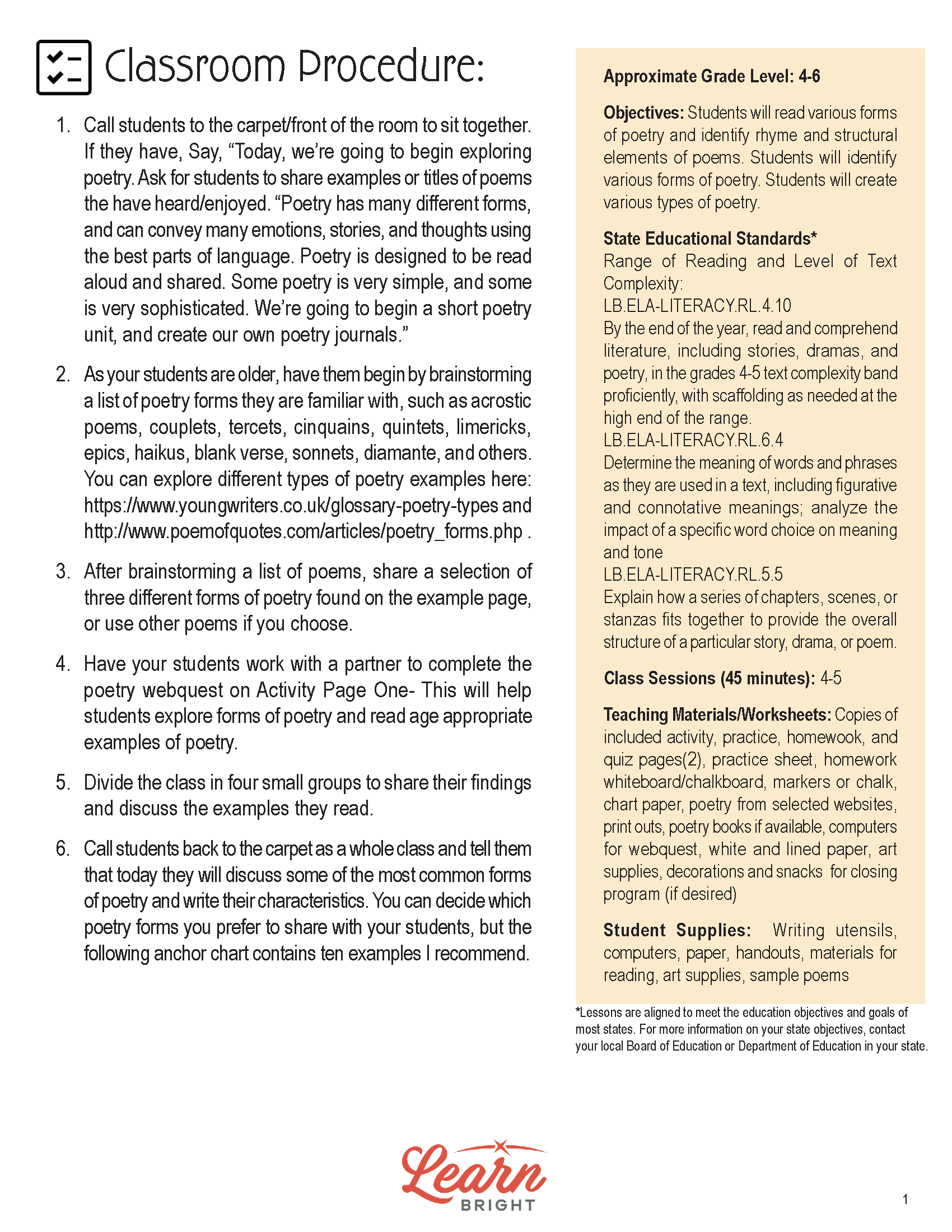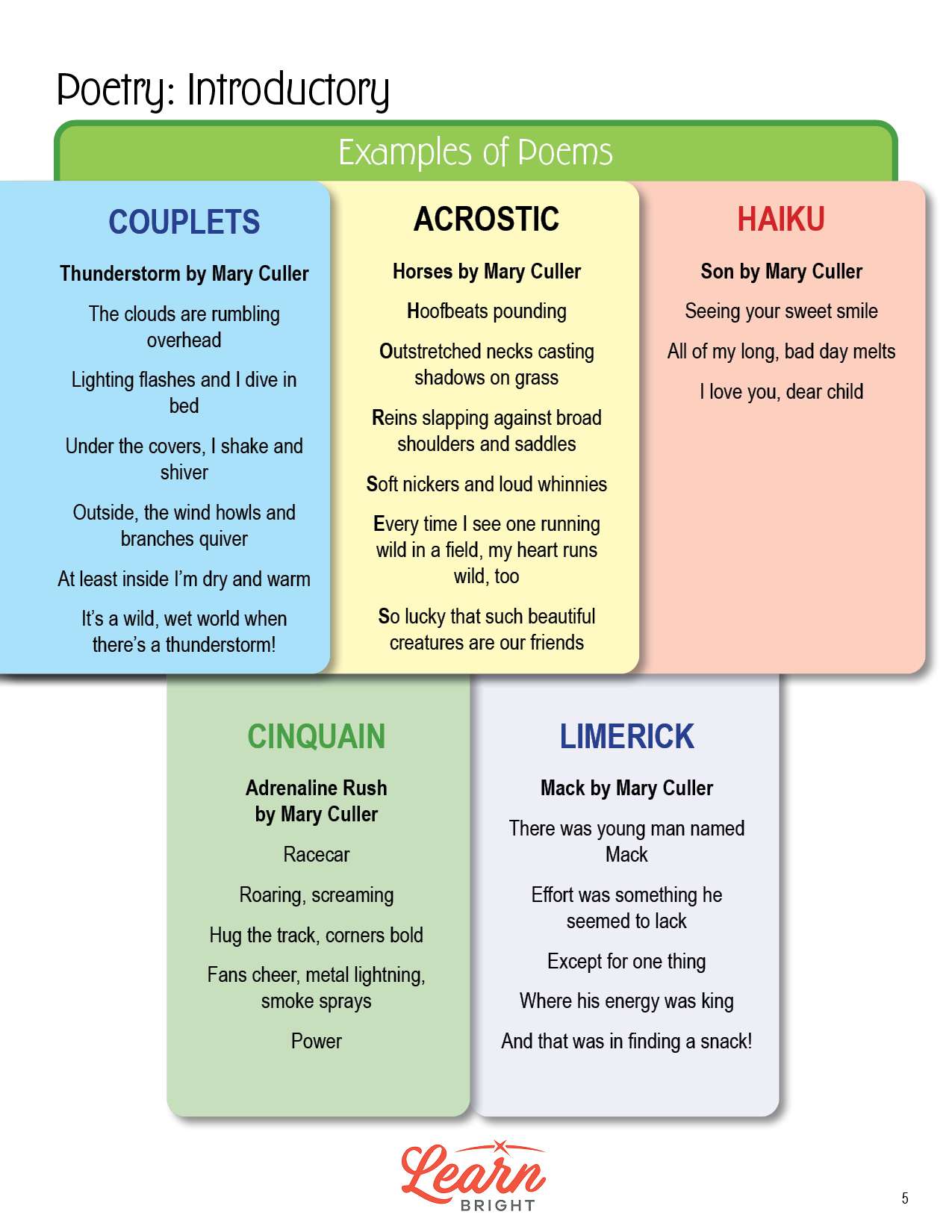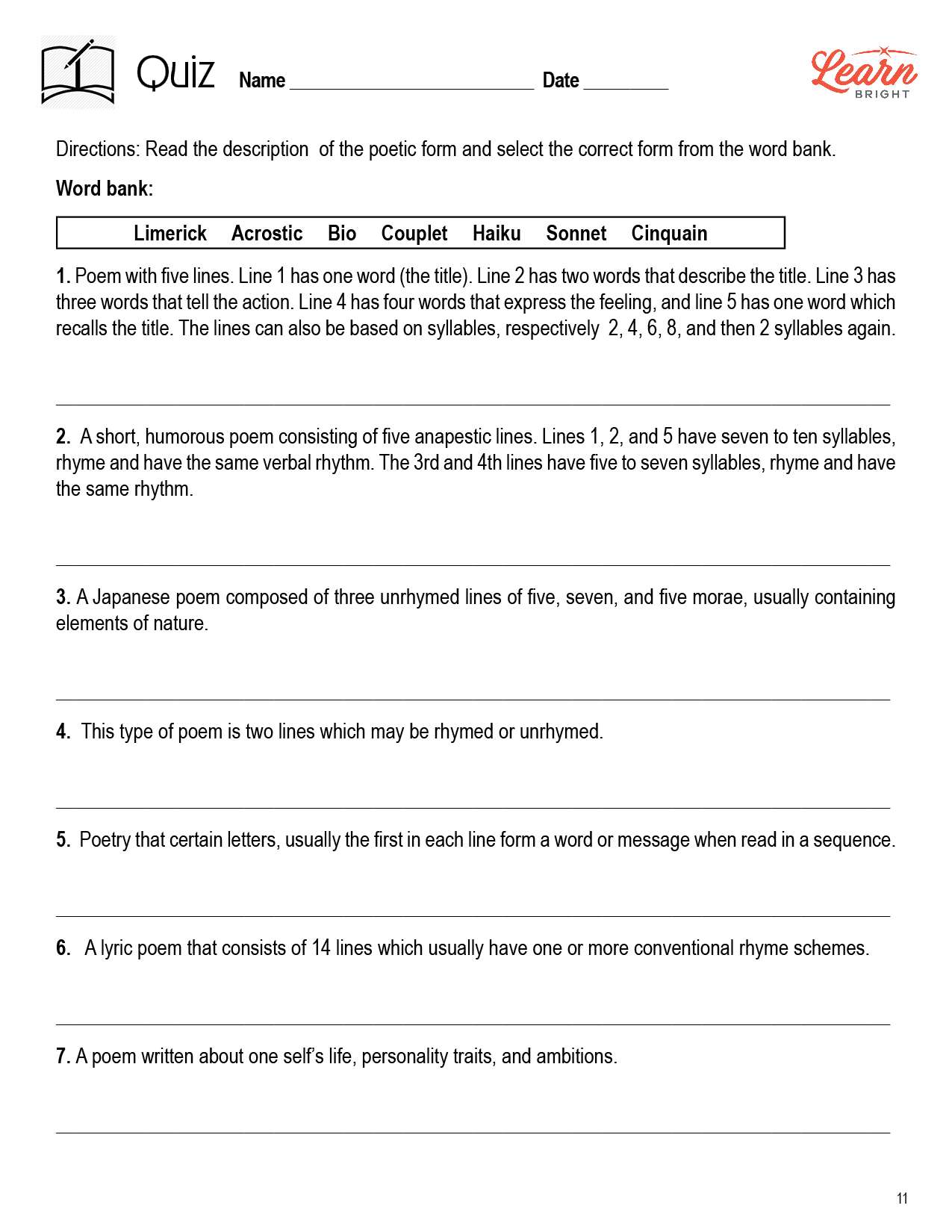Description
What our Introduction to Poetry – Grades 4-6 lesson plan includes
Lesson Objectives and Overview: Introduction to Poetry – Grades 4-6 lesson plan introduces students to the world of poetry. This lesson expands students’ exposure to a variety of poetry forms with engaging activities while also providing experiential learning as student practice identifying and matching the various forms. At the end of the lesson, students will be able to read various forms of poetry and identify rhyme and structural elements of poems, identify various forms of poetry, and create various types of poetry. This lesson is for students in 4th grade, 5th grade, and 6th grade.
Classroom Procedure
Every lesson plan provides you with a classroom procedure page that outlines a step-by-step guide to follow. You do not have to follow the guide exactly. The guide helps you organize the lesson and details when to hand out worksheets. It also lists information in the orange box that you might find useful. You will find the lesson objectives, state standards, and number of class sessions the lesson should take to complete in this area. In addition, it describes the supplies you will need as well as what and how you need to prepare beforehand.
For this lesson, the supplies you will need are the handouts, a whiteboard or chalkboard, markers or chalk, chart paper, poetry examples, computers, paper, art supplies, and decorations and snacks if you choose to do a closing program. To prepare for this lesson ahead of time, you can copy the handouts, gather the supplies, find resources for reading, and complete your own bio poem as an example.
Options for Lesson
Included with this lesson is an “Options for Lesson” section that lists a number of suggestions for activities to add to the lesson or substitutions for the ones already in the lesson. The suggestions for this lesson provide a guide for which parts of the lesson you can administer on which of the four days scheduled for the lesson. For example, for day one, it suggests having students brainstorm and discuss their experiences reading poems and engaging with different types of poetry, listen to some examples of poetry, and start their webquest.
Teacher Notes
The teacher notes page includes a paragraph with additional guidelines and things to think about as you begin to plan your lesson. It notes that poetry can be a challenging type of literature to teach, but that having students engage with poetry from a young age can help them as they get older. This page also includes lines that you can use to add your own notes as you’re preparing for this lesson.
INTRODUCTION TO POETRY – GRADES 4-6 LESSON PLAN CONTENT PAGES
Common Poetry Forms & Cinquains, Free Verse, Limerick, Haiku
The Introduction to Poetry – Grades 4-6 lesson plan includes only one content page. However, it provides a very detailed lesson plan, found on the three Classroom Procedure pages. The final Classroom Procedure page includes descriptions of nine different kinds of poetry: cinquain, free verse, limerick, haiku, acrostic, diamante, sonnet, bio poem, and couplet.
Students will learn that cinquains are poems with five lines. The first line has one word, which is the title. The second line has two words, which describe the title. The third line has three lines that describe the action, with the fourth line has four words that express the feeling of the poem. The fifth line has one word that references the title. This type of poem can also be structured according to the number of syllables, with the lines containing two, four, six, eight, and two syllables, in that order.
Free verse poetry is written as either rhymed or unrhymed lines with no fixed metrical pattern. Limericks, on the other hand, are short poems that are humorous and consist of five anapestic lines. The first, second, and fifth lines have between seven and ten syllables and rhyme. They also have the same verbal rhythm. The third and fourth lines each have between five and seven syllables, rhyme, and also have the same verbal rhythm. Haikus are Japanese poems that have three unrhymed lines that contain five, seven, and five syllables, in that order. These poems usually deal with themes related to nature.
Acrostic, Diamante, Sonnet, Bio Poem, Couplet & Poetry: Introductory
Students will next learn about acrostic poems, which are poems that spell a specific word with the first letter of each line. Diamante poems, on the other hand, are poems where the shape of the lines looks like a diamond. The first line introduces the beginning subject, the second line contain two words to describe the first line, and the third line contains three “doing” words about the first line. The fourth line has a short phrase related to the first line and a short phrase related to the seventh line. The fifth line contains three “doing” words about the seventh line and the sixth line contains two describing words about the seventh line. Finally, the seventh line is the end subject.
Sonnets are lyric poems that have 14 lines and use a conventional rhyme scheme. Bio poems are written about someone’s own life, personality, or ambitions. Finally, couplets contain two rhymed or unrhymed lines. Next, the content page, titled Poetry: Introductory, provides students with examples of five different kinds of poetry: couplets, acrostic, haiku, cinquain, and limerick. The poet Mary Culler wrote all five example poems.
INTRODUCTION TO POETRY – GRADES 4-6 LESSON PLAN WORKSHEETS
The Introduction to Poetry – Grades 4-6 lesson plan includes four worksheets: an activity worksheet, a practice worksheet, a homework assignment, and a quiz. You can refer to the guide on the classroom procedure page to determine when to hand out each worksheet.
ONLINE RESEARCH ACTIVITY WORKSHEET
Students will use the internet for this activity worksheet. First, they will go to a website to select three poems and write down their titles and authors. They will then determine which of the three poems is their favorite and why and identify what form their favorite poem was in. Next, they will go to a different website and choose two forms of poetry that they haven’t heard about. They will then search for some examples of those types of poetry. They will need to write down which forms they researched, write descriptions for both, and write the titles of the examples that they found as well. Finally, they will go to a third website, read the rules for writing a cinquain, and write one of their own!
MATCHING PRACTICE WORKSHEET
For the practice worksheet, students will read descriptions of different types of poetry (cinquain, limerick, haiku, acrostic, and sonnet) and match them to example poems.
BIO POEM HOMEWORK ASSIGNMENT
The homework assignment asks students to write their own bio poems and draw a self-portrait. They will use the provided template to help plan their poem and will then rewrite it on blank lines. Next, they’ll either draw a self-portrait or attach a photo of themselves to the page.
INTRODUCTION TO POETRY QUIZ
This lesson includes a quiz to test students’ understanding of the lesson material. For the quiz, they will have to read descriptions of various poetic forms and match them with words from a word bank. The words in the word bank include limerick, acrostic, bio, couplet, haiku, sonnet, and cinquain.
Worksheet Answer Keys
This lesson plan includes answer keys for the activity worksheet, the practice worksheet, the homework assignment, and the quiz. However, the answer keys for both the activity worksheet and the homework assignment note that students’ answers will vary. If you choose to administer the lesson pages to your students via PDF, you will need to save a new file that omits these pages. Otherwise, you can simply print out the applicable pages and keep these as reference for yourself when grading assignments.









